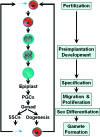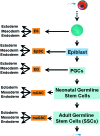Potency of germ cells and its relevance for regenerative medicine
- PMID: 18565110
- PMCID: PMC2475561
- DOI: 10.1111/j.1469-7580.2008.00930.x
Potency of germ cells and its relevance for regenerative medicine
Abstract
Germline stem cells, which can self-renew and generate gametes, are unique stem cells in that they are solely dedicated to transmit genetic information from generation to generation. The germ cells have a special place in the life cycle because they must be able to retain the ability to recreate the organism, a property known as developmental totipotency. Several lines of evidence have suggested the extensive proliferation activity and pluripotency of prenatal, neonatal and adult germline stem cells. We showed that adult male germline stem cells, spermatogonial stem cells, can be converted into embryonic stem cell-like cells, which can differentiate into the somatic stem cells of three germ layers. Different cell types such as vascular, heart, liver, pancreatic and blood cells could also be obtained from these stem cells. Understanding how spermatogonial stem cells can give rise to pluripotent stem cells and how somatic stem cells differentiate into germ cells could give significant insight into the regulation of developmental totipotency as well as having important implications for male fertility and regenerative medicine.
Figures



References
-
- Anderson O, Heasman J, Wylie C. Early events in the mammalian germ line. Int Rev Cytol. 2001;203:215–230. - PubMed
-
- Cooke JE, Godin I, Ffrench-Constant C, et al. Culture and manipulation of primordial germ cells. Methods Enzymol. 1993;225:37–58. - PubMed
-
- Damjanov I. Teratocarcinoma stem cells. Cancer Surv. 1990;2:303–319. - PubMed
-
- Donovan PJ. The germ cell – the mother of all stem cells. Int J Dev Biol. 1998;42:1043–1050. - PubMed
-
- Donovan P, de Miguel M. Turning germ cells into stem cells. Curr Opin Genet Dev. 2004;13:463–471. - PubMed
Publication types
MeSH terms
LinkOut - more resources
Full Text Sources

